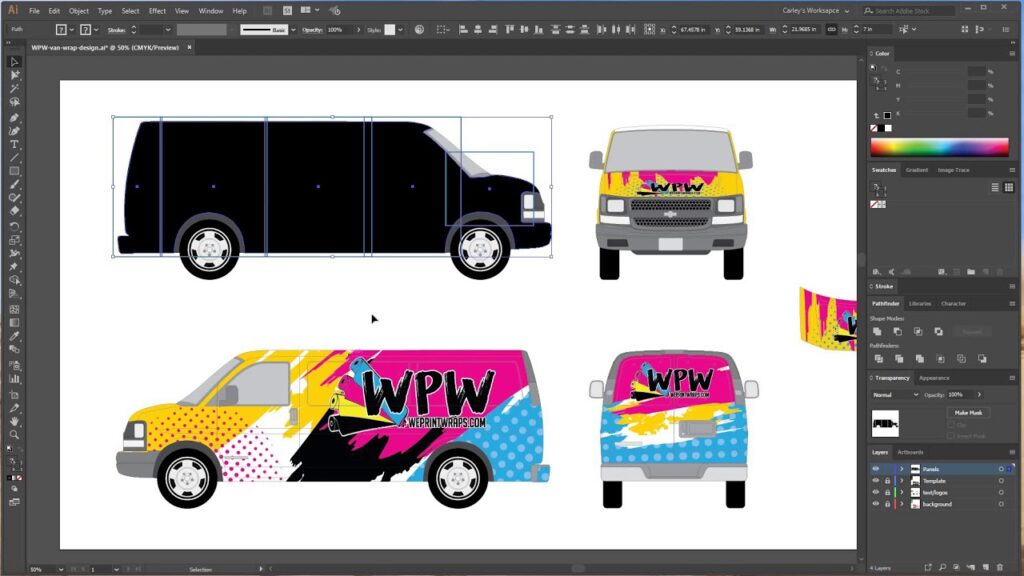Mastering Vehicle Wrap Design: A Comprehensive Guide to Creating Vector Graphics in Adobe Illustrator

Introduction: Vehicle wraps have become a ubiquitous form of advertising, transforming ordinary vehicles into eye-catching mobile billboards that capture attention on the road. Adobe Illustrator, with its powerful vector-based tools and extensive features, provides designers with the perfect platform to create stunning graphics for vehicle wraps. In this comprehensive guide, we’ll explore the step-by-step process of designing vector graphics for vehicle wraps in Adobe Illustrator, covering everything from conceptualization to final implementation.
Section 1: Understanding the Impact of Vehicle Wrap Design 1.1 The Rise of Vehicle Wraps: Explore the growing popularity of vehicle wraps as a cost-effective and versatile form of advertising, reaching a wide audience in various locations and demographics. 1.2 Visual Impact: Discuss the visual impact of vehicle wraps in grabbing attention, increasing brand visibility, and conveying marketing messages effectively on the move. 1.3 Design Considerations: Examine the unique design considerations for vehicle wraps, including vehicle contours, viewing angles, and visibility from different distances and speeds.
Section 2: Planning Your Vehicle Wrap Design 2.1 Defining Design Objectives: Determine the goals and objectives of your vehicle wrap design, whether to promote a brand, advertise products/services, or convey a specific message or theme. 2.2 Vehicle Analysis: Gather information about the vehicle make, model, dimensions, and surface areas available for wrapping, ensuring accurate design specifications and measurements. 2.3 Research and Inspiration: Gather inspiration from diverse sources, including brand guidelines, industry trends, competitor analysis, and visual references, to inform your creative direction and conceptualization.
Section 3: Getting Started with Adobe Illustrator 3.1 Overview of Adobe Illustrator: Familiarize yourself with the Illustrator workspace, tools, and essential features for creating vector graphics. 3.2 Setting Up Your Document: Create a new document in Illustrator, specifying the dimensions, color mode, and resolution suitable for vehicle wrap design. 3.3 Organizing Layers and Artboards: Utilize layers and artboards to organize your design elements systematically, facilitating efficient design and editing workflows.
Section 4: Designing Your Vehicle Wrap Graphics 4.1 Vehicle Template Setup: Obtain or create a vehicle template in Illustrator, accurately representing the dimensions and contours of the target vehicle for precise design placement. 4.2 Branding and Identity: Incorporate brand logos, colors, and visual elements seamlessly into your vehicle wrap design, ensuring brand consistency and recognition. 4.3 Visual Composition: Establish a visual hierarchy and composition for your vehicle wrap design, balancing branding elements, imagery, and text to maximize impact and readability. 4.4 Creating Vector Graphics: Use Illustrator’s vector-based tools to create scalable graphics, illustrations, icons, and patterns for your vehicle wrap design, focusing on clarity, simplicity, and visual appeal.
Section 5: Typography and Text Integration 5.1 Selecting Fonts: Choose appropriate typefaces and font styles for your vehicle wrap design, ensuring readability and visual coherence with the overall branding and messaging. 5.2 Crafting Compelling Copy: Write concise, impactful copy that communicates key messages, contact information, and calls-to-action effectively within the limited space of the vehicle wrap. 5.3 Text Placement and Formatting: Position text strategically within your vehicle wrap design, considering visibility, legibility, and aesthetic balance, and experimenting with formatting options such as alignment, spacing, and text effects.
Section 6: Color Palette and Branding 6.1 Choosing Color Scheme: Select a cohesive color palette that reflects the brand identity, evokes the desired mood, and enhances visibility and impact on the vehicle wrap. 6.2 Branding Integration: Integrate brand colors, logos, and visual motifs seamlessly into your vehicle wrap design, reinforcing brand recognition and association. 6.3 Ensuring Contrast and Legibility: Ensure sufficient contrast between text and background elements, as well as high legibility from a distance, to maximize readability and comprehension of your vehicle wrap design.
Section 7: Finalizing and Exporting Your Vehicle Wrap Design 7.1 Reviewing and Proofing: Conduct thorough reviews of your vehicle wrap design, checking for accuracy, consistency, and alignment with client requirements and branding guidelines. 7.2 Adjustments and Revisions: Make necessary adjustments or revisions based on feedback from stakeholders or testing, refining your vehicle wrap design until it meets the desired standards and objectives. 7.3 Exporting Files for Printing: Prepare your vehicle wrap design for printing by exporting it in the appropriate file format (e.g., AI, PDF, EPS) and resolution, ensuring compatibility with print production processes and output devices.
Section 8: Application and Implementation 8.1 Printing and Installation: Work with printing vendors or vehicle wrap installers to produce and install your vehicle wrap design, ensuring accurate color reproduction, material quality, and installation precision. 8.2 Testing and Evaluation: Conduct field tests or mockups of your vehicle wrap design on the target vehicle, evaluating visibility, alignment, and overall impact in real-world conditions. 8.3 Launch and Promotion: Launch your vehicle wrap campaign with a cohesive marketing strategy, including press releases, social media announcements, and promotional events, to generate buzz and engagement.
Conclusion: Designing vector graphics for vehicle wraps in Adobe Illustrator offers businesses and marketers a dynamic platform to create impactful advertising that reaches audiences on the move. By following the comprehensive steps outlined in this guide, you’ll be equipped to create vehicle wrap designs that captivate attention, enhance brand visibility, and drive engagement. So, unleash your creativity, embrace the possibilities, and embark on your journey to design vector graphics that leave a lasting impression on the roads.







